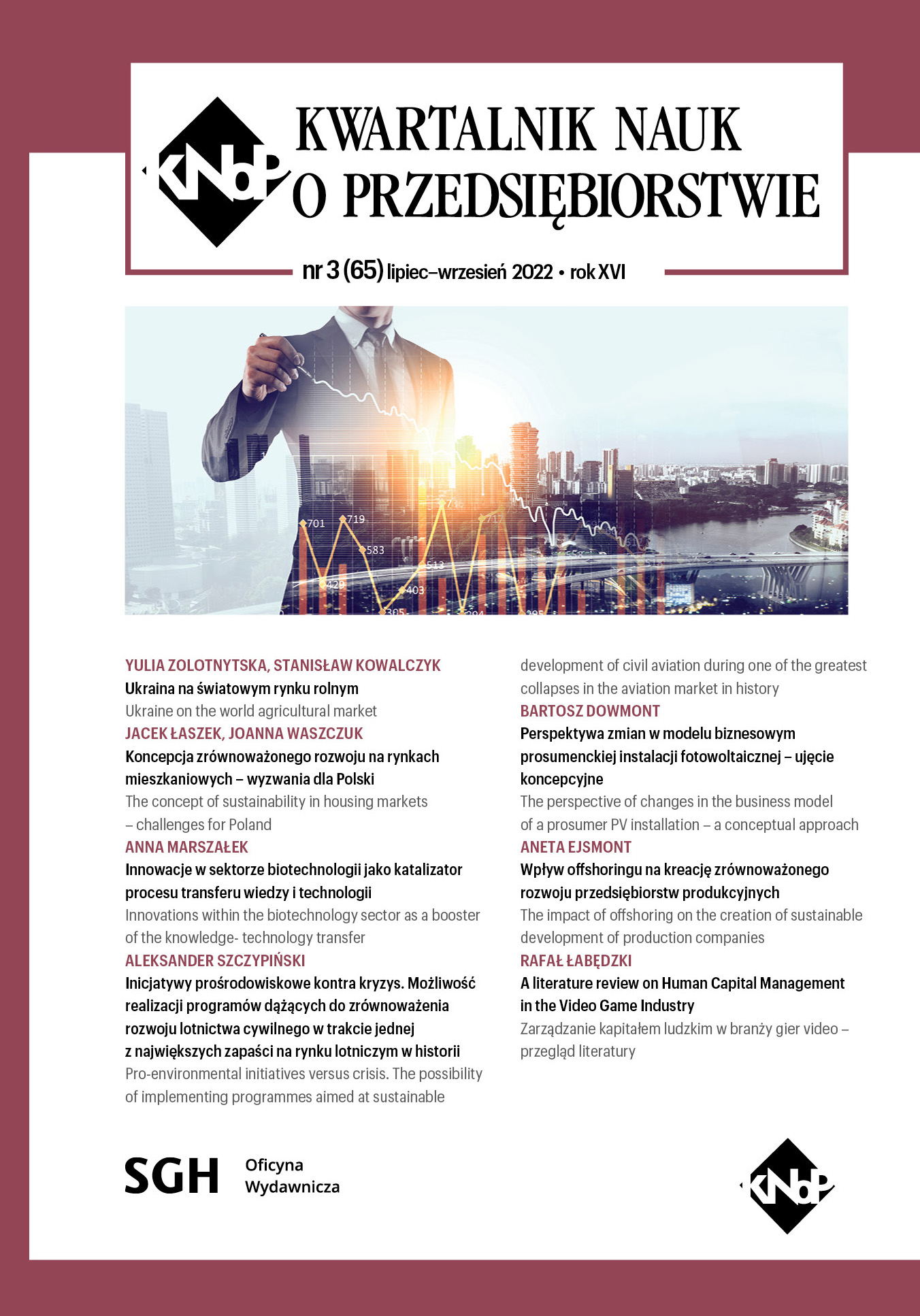The impact of offshoring on the creation of sustainable development of production companies
Main Article Content
Abstract
The presented article deals with the problem of the insufficient level of added value in industry per one employee in 2009–2021 which is the key measure of the level of sustainable development. The study covered companies from 60 countries of the world most often chosen as the location of offshoring processes. The aim of this article is to verify the research hypothesis, according to which the significant impact of offshoring on the sustainable development of industrial enterprises is an important condition in the process of promoting the sustainable industrialization of their activities. The research method is the estimation of an econometric model, which confirms the
high impact of the offshoring attractiveness of services in financial terms on the gross value added in industry (including construction too) per employee.
Downloads
Article Details
The author of the article declares that the submitted article does not infringe the copyrights of third parties. The author agrees to subject the article to the review procedure and to make editorial changes. The author transfers, free of charge, to SGH Publishing House the author's economic rights to the work in the fields of exploitation listed in the Article 50 of the Act of 4 February 1994 on Copyright and Related Rights – provided that the work has been accepted for publication and published.
SGH Publishing House holds economic copyrights to all content of the journal. Placing the text of the article in a repository, on the author's home page or on any other page is allowed as long as it does not involve obtaining economic benefits, and the text will be provided with source information (including the title, year, number and internet address of the journal).
References
Baskaran G. (2021), Firms’ Approach to Mitigating Risks in the Platinum Group Metals Sector, “Mineral Economics”, Vol. 34, s.385–398.
Cai J., Leung P. (2020), A Note on Linkage Between Gross Value Added and Final Use at the Industry Level, “Economic Systems Research”, Vol 32, No. 3, s. 428–437.
Cele Zrównoważonego Rozwoju (2021), http://www.un.org.pl/biznes-i-cele-zrownowazonegorozwoju (dostęp: 27.04.2021).
Czarnas M. (2014), Atrakcyjność lokalizacji usług offshoringowych w Polsce na tle wybranych krajów Europy Środkowo- Wschodniej, „Prace naukowe Uniwersytetu Ekonomicznego we Wrocławiu”, nr 369, s. 148–159.
Feenstra R. C. (2010), Offshoring in the Global Economy, Vol. IX, London, The MIT Press, Cambridge, Mass.
GUS (2021), Pojęcia stosowane w statystyce publicznej, https://stat.gov.pl/metainformacje/slownikpojec/pojecia-stosowane-w-statystyce-publicznej/563, pojecie.html (dostęp: 01.05.2021).
Hamel G., Prahalad C. K. (1999), Przewaga konkurencyjna jutra. Strategie przejmowania kontroli nad branżą i tworzenie rynków przyszłości, Warszawa, Wydawnictwo Business Press.
Harms P. (2011), Feenstra R. C.: Offshoring in the Global Economy IX, 148 pp. The MIT Press, Cambridge, Mass., London 2010. Hardback $ 30,00, “Journal of Economics”, Vol. 102, No. 3, s. 291–293.
Hertveldt B. (2013), Michel B., Offshoring and the Skill Structure of Labour Demand in Belgium, “De Economist”, Vol. 161, s. 399–420.
Pisani N., Ricart J. E. (2016), Offshoring of Services: A Review of the Literature and Organizing Framework, “Management International Review”, Vol. 56, s. 385–424.
Kearney A. T. (2021), Toward a Global Network of Digital Hubs. The 2021 A. T. Kearney Global Services Location Index, Chicago.
Kearney A. T. (2019), Digital Resonance: The New Factor Impacting Location Attractiveness, The 2019 A. T. Kearney Global Services Location Index, Automation and Cybersecurity are Increasingly Becoming Key Factors in Outsourcing Decisions, Chicago.
Kearney A. T. (2017), Global Services Location Index. The Widening Impact of Automation. Developing Nations Have Long Enjoyed The Economic Benefits of Other Countries’ Offshoring. Now This Model is in Danger as Technology Takes Over Much of Business Process Outsourcing, Chicago.
Kearney A. T. (2016), Global Services Location Index. On The Eve on Disruption. A New Business Model Threatens Established Concepts of Offshoring and Expands The Market, Chicago.
Kearney A. T. (2014), The 2014 A. T. Kearney Global Services Location Index. A Wealth of Choices: From Anywhere on Earth to No Location at All. Back-office Services are Now Embarking on a Third Wave of Arbitrage, as Automation Becomes Simpler, Chicago.
Kearney A. T. (2011), Offshoring Opportunities Amid Economic Turbulence. The A. T. Kearney Global Services Location Index, Chicago.
Kearney A. T. (2009), The Shifting Geography of Offshoring. The 2009 A. T. Kearney Global Services Location Index, Chicago.
Koop G. (2014), Wprowadzenie do ekonometrii, Warszawa, Oficyna a Wolters Kluwer business.
Kufel T. (2013), Ekonometria. Rozwiązywanie problemów z wykorzystaniem programu GRETL, Warszawa, Wydawnictwo Naukowe PWN.
Organizacja Narodów Zjednoczonych (2015), Rezolucja przyjęta przez Zgromadzenie Ogólne w dniu 25 września 2015 r. 70/1. Przekształcamy nasz świat: Agenda na rzecz zrównoważonego rozwoju 2030 przygotowana przez Organizację Narodów Zjednoczonych, Nowy Jork.
RICOH (2021), Planeta, społeczeństwo oraz zarządzanie i polityka firmy, https://www.ricoh.pl/o-nas/zrownowazony-rozwoj (dostęp: 21.04.2021).
Sachs J. D. (2012), From Millennium Development Goals to Sustainable Development Goals, „The Lanced”, No 379, No. 9832, s. 2206–2211.
Smid W. (2012), Boss Leksykon, Kraków, Wydawnictwo DR Lex.
Trzepacz P. (2012), Geneza i istota koncepcji rozwoju zrównoważonego: Zrównoważony rozwój – wyzwania globalne. Podręcznik dla uczestników studiów doktoranckich, P. Trzepacz (red.), Kraków, Wydawnictwo Instytutu Geografii i Gospodarki Przestrzennej Uniwersytetu Jagiellońskiego, s. 15.
Zimniewicz K. (2014), Teoria i praktyka zarządzania. Analiza krytyczna, Warszawa, Polskie Wydawnictwo Ekonomiczne.
Zimniewicz K. (2011), Outsourcing, offshoring czy nearshoring?, „Przedsiębiorczość i Zarządzanie”, nr 12 (14), s. 73–77.

